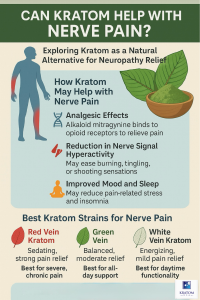🌿 Kratom and Nerve Pain
Nerve pain, also known as neuropathy, affects millions of people worldwide and is often chronic, debilitating, and difficult to treat. Common causes include diabetes, injury, chemotherapy, and nerve compression. Traditional medications—like opioids or antidepressants—don’t always provide sufficient relief and can cause undesirable side effects. This has led many to explore natural alternatives like kratom (Mitragyna speciosa). But can kratom help with nerve pain?
Let’s take a science-based look at kratom’s potential for relieving neuropathic pain, the best strains to consider, and how to use it safely.
📌 Key Points: Kratom and Nerve Pain Relief
-
🧪 Kratom contains alkaloids like mitragynine and 7-hydroxymitragynine, which interact with pain and opioid receptors
-
🔬 Some studies suggest kratom may reduce pain signals and nerve hypersensitivity
-
🌿 Certain kratom strains may ease burning, tingling, or shooting pain associated with neuropathy
-
✅ Many users report effective relief from chronic nerve pain symptoms
-
⚠️ Kratom is not FDA-approved; safe, moderate use is essential
🧠 Understanding Nerve Pain (Neuropathy)
Nerve pain occurs when the peripheral nervous system is damaged or irritated. It’s different from regular pain because it often involves burning, shooting, tingling, or stabbing sensations. Conditions linked to neuropathic pain include:
-
Diabetic neuropathy
-
Sciatica
-
Postherpetic neuralgia (shingles)
-
Multiple sclerosis
-
Spinal cord injuries
-
Chemotherapy-induced neuropathy
Neuropathic pain is notoriously resistant to treatment, which is why many seek alternative or complementary approaches.
🌿 How Kratom May Help with Nerve Pain
 🔹 1. Analgesic Effects Through Opioid Receptors
🔹 1. Analgesic Effects Through Opioid Receptors
The alkaloid mitragynine in kratom binds to mu-opioid receptors in the brain and spinal cord. These are the same receptors activated by prescription painkillers, but kratom acts as a partial agonist—which may offer relief with fewer respiratory risks.
📖 A 2022 article in Frontiers in Pharmacology noted that mitragynine exhibited significant pain-blocking effects in animal models.
🔹 2. Reduction in Nerve Signal Hyperactivity
Kratom may help calm overactive nerve signals, which are often responsible for sharp, shooting, or burning pain. Though direct studies on kratom and neuropathy are limited, anecdotal reports and preliminary science suggest a possible mechanism through:
-
Inhibition of inflammatory cytokines
-
Modulation of calcium and sodium ion channels
These are the same targets as gabapentin and pregabalin, commonly prescribed for neuropathy.
🔹 3. Improved Mood and Sleep
Neuropathic pain is often accompanied by insomnia, anxiety, and depression. Kratom may support nerve pain indirectly by:
-
Promoting restorative sleep (especially red strains)
-
Enhancing mood and mental resilience
-
Reducing pain-related stress
🌱 Best Kratom Strains for Nerve Pain
The strain and vein color you choose matters. Some strains are better for sedation and deep pain relief, while others support daytime functionality.
🔴 Red Vein Kratom – Best for Deep, Chronic Pain
-
Strains: Red Bali, Red Borneo, Red Maeng Da
-
Effects: Sedation, muscle relaxation, strong analgesia
-
Best For: Nighttime use, severe burning or shooting pain
🟢 Green Vein Kratom – Balanced Relief + Focus
-
Strains: Green Malay, Green Maeng Da
-
Effects: Moderate pain relief with mood boost
-
Best For: Daytime use, nerve pain with fatigue
⚪ White Vein Kratom – Mild Pain + Energy
-
Strains: White Thai, White Borneo
-
Effects: Energy, alertness, light pain support
-
Best For: Neuropathy sufferers who need daytime productivity
💊 How to Use Kratom for Nerve Pain Relief
✅ Dosage Guidelines (Start Low)
| Level | Dose | Effect |
|---|---|---|
| Low | 1–2 grams | Light energy, mild relief |
| Moderate | 2.5–4 grams | Balanced pain relief |
| High | 5–6 grams | Strong pain reduction, sedation |
-
Start with 2–3 grams, especially if new to kratom
-
Avoid using daily to prevent tolerance
-
Rotate strains to maintain efficacy
-
Take kratom 1–2 hours before peak pain periods
🛒 Choose lab-tested kratom from trusted vendors like Kratom USA for purity and consistency.
⚠️ Safety, Side Effects, and Considerations
While many find kratom helpful for nerve pain, it must be used responsibly:
-
Side effects may include nausea, dizziness, or constipation
-
Long-term use can lead to dependence
-
Do not mix with opioids, alcohol, or sedatives
-
Not recommended for pregnant women or those with liver issues
🤔 FAQ: Kratom and Nerve Pain
❓ Can kratom really help with nerve pain?
Many users report significant relief from burning, stabbing, or tingling nerve pain, especially with red or green strains. Preliminary studies support kratom’s analgesic properties.
❓ How is kratom different from gabapentin or opioids?
Kratom acts on similar receptors but in a more balanced and partial way. It may cause fewer side effects in some individuals but lacks long-term safety data.
❓ What’s the best kratom strain for neuropathy?
Red Bali and Green Malay are most commonly recommended for nerve pain.
❓ Is kratom addictive?
It can be habit-forming if used daily at high doses. Stick to moderate, rotational use to minimize this risk.
❓ Is kratom legal?
Kratom is legal in most U.S. states, but check your local laws. It is banned in some areas and not FDA-approved.
🌿 Final Thoughts: Can Kratom Offer Real Relief for Nerve Pain?
While kratom isn’t a cure or a first-line treatment, it holds real promise as a natural alternative for people struggling with chronic nerve pain. With careful use, the right strain, and realistic expectations, kratom may help you regain mobility, reduce pain, and improve quality of life.
📦 Ready to explore premium kratom for nerve pain relief?
Visit KratomUSA.com for lab-tested red and green vein strains trusted by those seeking natural alternatives.


